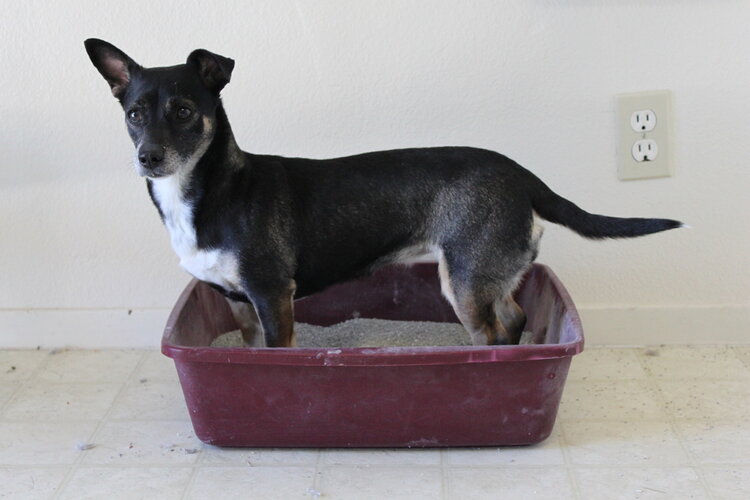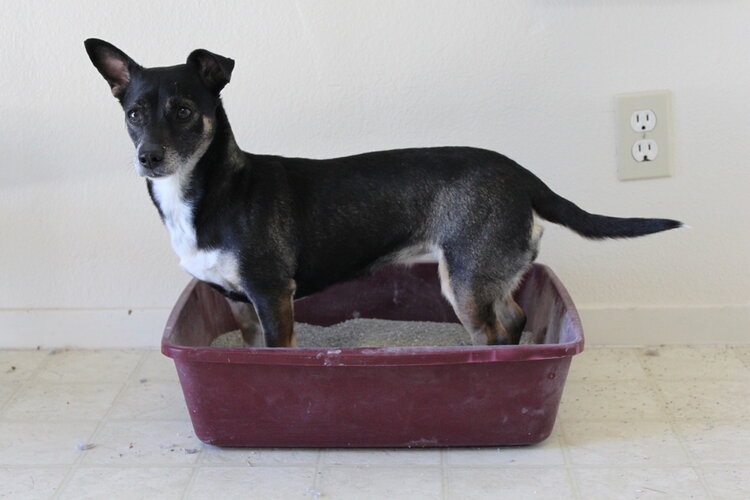- March 29, 2024
Is Dog Litter Real? Facts, Pros, Cons & Set Up Tips


While litter boxes are mostly associated with cats and some small pets, dogs can also be litter box trained. Dog litter is an alternative to puppy pee pads, and it can be a helpful backup for dogs to relieve themselves while you’re away from home. However, it does have some disadvantages that may not make it the best option for some dogs. So, it’s important to spend time weighing the pros and cons before deciding to use dog litter.

What Is Dog Litter?
Dog litter comes in different forms. The most common types of dog litter you’ll come across include newspaper pellets and clumping clay. Dog litter does often look and act similarly to cat litter. So, you could technically use cat litter if your local pet store doesn’t carry any dog litter.

Advantages of Dog Litter
Dog litter has several advantages that can make it a better alternative to puppy pee pads. First, dog litter is often incorporated with deodorizing and odor-locking ingredients, so it can do a better job of reducing urine odors than puppy pee pads.
The texture of dog litter feels more natural than flat puppy pee pads, so dogs often have an easier time getting used to using them. Many dogs can mistake rugs for pee pads and are more likely to have accidents in the home. Dog litter can reduce the occurrence of potty accidents in the home because it doesn’t bear any resemblance to carpets and rugs.
Lastly, dog litter can be an eco-friendlier option than pee pads if you use dog litter made with recycled or biodegradable materials. In contrast, pee pads use plastic and will take up more landfill space than eco-friendly dog litter.

Disadvantages of Dog Litter
There are cases in which dog litter isn’t the best option for some dogs. First, it’s most commonly used with smaller dogs. This is because dog litter is usually capable of absorbing urine for smaller dogs, but larger dogs may produce too much urine for litter boxes. It’s also difficult to find litter boxes designed for medium and large dog breeds, so larger dogs can miss the litter box.
For obvious reasons, dog litter isn’t a good option for dogs that like to dig. It can get messy very quickly for both dogs that like to dig and dogs that like to scratch their paws against the ground after they relieve themselves.

How to Set Up a Dog Litter Box

If you think using a dog litter box would be good for your dog, it’s important to create a substantial litter box station. First, purchase a litter box that’s big enough for your dog. Your dog should be able to fit inside the box and have a little extra room. It’s also important to get a litter box hood or a litter box with high walls, especially if you have a male dog. This will prevent splashing and urine leaking to your floors.
Next, choose your dog litter. Pellets are usually the eco-friendlier option, but you also have to change out this type of dog litter and clean the litter box more frequently than clumping dog litter. While clumping dog litter offers more convenient cleanup, it can be messier than pellets. It’ll get stuck to your dog’s paws, and it’s likely that you’ll find dog litter tracks around your house. If you choose to use clumping dog litter, make sure also to purchase a litter box mat. A litter box mat will help trap dog litter that sticks to your dog’s paws and reduce the amount of tracking.
Make sure to purchase a dog litter scoop. Scooping out urine and feces from the dog litter box will help make dog litter last longer and reduce odors from permeating throughout your home. You can also purchase litter additives or deodorizing crystals and mix them into the dog litter to trap odors.

Conclusion
Overall, dog litter is a considerable choice for smaller dogs that require frequent potty breaks. It usually isn’t a good option for larger dogs because it may not be able to absorb and contain their urine adequately.
If you plan to use dog litter, make sure to weigh your options and choose the right kind of dog litter and litter box accessories. Having a good litter box setup will help reduce litter box odors and keep messes contained, and you’ll be sure to reap all the additional benefits that dog litter has to offer.
Featured Image Credit: Jenn_C, Shutterstock
Tags
What do you think?
Related Articles

New Puppy Checklist: Gear You’ll Need for Your New Dog
Getting a new puppy is really exciting, but before you welcome them home, it’s important to prepare your space for them. Since puppies need a

How Big Do Mini Poodles Get? Vet Reviewed Average Weight & Growth Chart – Dogster
The information is current and up-to-date in accordance with the latest veterinarian research. Learn more » When you buy a Miniature Poodle, you might not

Can Police Dogs Smell Nicotine? Vet Verified Facts & Info – Dogster
The information is current and up-to-date in accordance with the latest veterinarian research. Learn more » While cigarette sales have been declining steadily for decades,

How Old Is 5 in Dog Years? Vet-Approved Guide to Each Size of Dog – Dogster
The information is current and up-to-date in accordance with the latest veterinarian research. Learn more » A common method for calculating a dog’s age is

